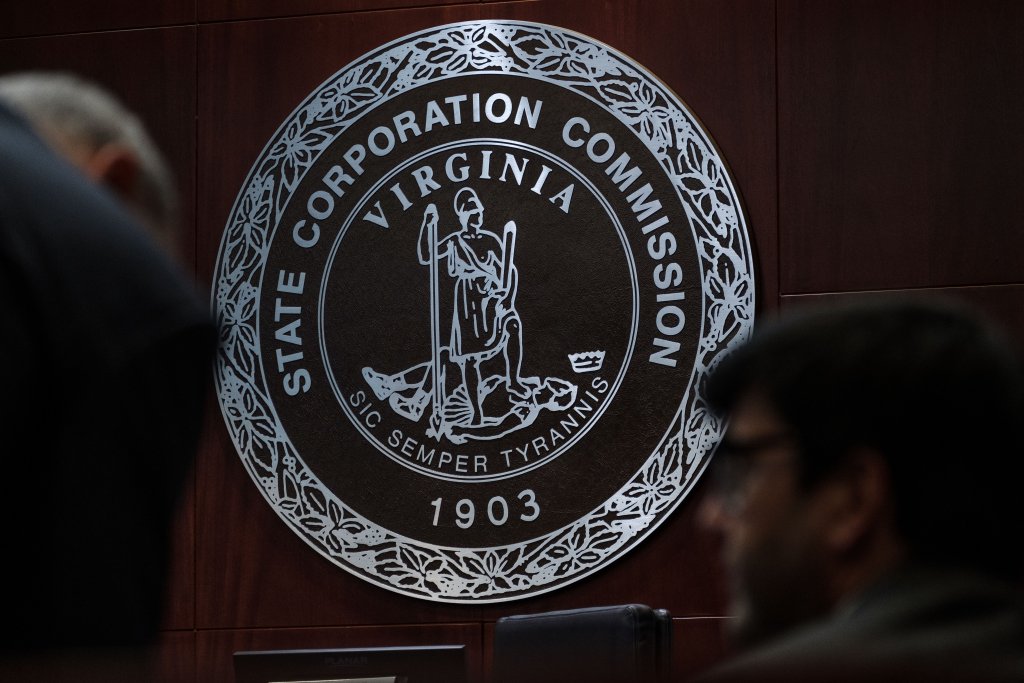The State Corporation Commission regulates Virginia electric utilities. (Ned Oliver/ Virginia Mercury)
Energy use is skyrocketing across Virginia with the proliferation of new data centers, but as it turns out, we are not alone. Across the country, the rise of artificial intelligence and its voracious demand for power has prompted tech companies to locate new data centers wherever they think they can secure the necessary land, energy and water supplies. The result is upending utility planning everywhere.
Now what the heck do we do about data centers?
One utility in Ohio has proposed a requirement that data centers commit to 10-year service contracts requiring them to pay at least 90% of the cost of the electricity they ask for, regardless of whether the data centers end up using that much power.
AEP Ohio says it has received service inquiries from data centers totaling 30 gigawatts of new power demand, and that serving all those new data centers would require a massive investment in expensive transmission lines. The utility wants to ensure other ratepayers aren’t stuck with the bill if the data centers leave town, if the AI boom goes bust, or if technological breakthroughs reduce the amount of energy they need.
The data center industry is apoplectic, but other utilities and their regulators are watching closely to see if this is a requirement they should adopt, too. This includes Virginia’s State Corporation Commission, which on October 2 announced plans for a technical conference on data centers to discuss “issues related to servicing this new electrical load.” Specific topics on the agenda include minimum bills for data centers, contract term lengths and whether certain transmission and/or generation costs should be directly assigned to a new customer class consisting of large-use customers like data centers.
The conference is scheduled for December 16, and those who want to participate as panelists can nominate themselves on or before October 22.
AEP Ohio’s solution is not as novel as it might sound. It is normal for new industrial customers to be required to guarantee they will buy at least most of the electricity they say they will need. It’s a reasonable ask: a utility that spends millions of dollars on infrastructure to serve a new factory needs to make sure costs are covered if the factory folds up shop.
Normally, though, the customer has to guarantee it will buy 60-70% of the electricity it has asked for, not 90%. Tech companies complain it is unfair to require more of data centers than of other industries. If the higher number is approved, they warn, they may decide to locate in some other state.
(Seriously? If they were to use that talking point in Virginia, the response from residents might be, “Is that a threat or a promise?”)
In fact, there are good reasons to treat data centers differently. One is the sheer scale of the energy demand involved, meaning a lot more money is at risk. AEP Ohio projects that electricity use in Central Ohio will more than double between 2018 and 2028 due to the growth of the data center industry.
Another concern is that data centers operate more like warehouses than factories. It’s hard to move a factory, so it is likely to use a predictable level of electricity over a long period of time. By contrast, the contents of a warehouse (in this case, racks of servers) can be moved somewhere else if market conditions change. I wrote recently about the potential of enhanced geothermal energy as a low-cost, renewable technology that is already starting to outcompete fossil fuels in western states. Utilities are right to worry about tech companies pulling out to chase cheaper, greener energy elsewhere.
Finally, there is the question of whether this enormous energy demand is as real as it feels right now. Analysts have been questioning whether AI might be a bubble. If companies can’t make it profitable soon, the demand they project might evaporate, leaving a lot of data centers empty and utilities with infrastructure no one needs.
Another, happier route to lower energy demand could be more energy-efficient operations. The data center industry as a whole has cut energy waste significantly over the years, and research suggests there may be further gains in efficiency coming. Quantum computing is frequently cited as one tool to unlock efficiencies. More dramatically, University of Minnesota researchers recently developed hardware that they say can lower the energy consumption of AI applications by “a factor of 1000.”
Quite possibly, the best outcome for society would be for the data center boom to go bust, reducing any need for utilities to burn more fossil fuels and relieving communities of impacts on neighborhoods, parks and water resources. But utility regulators can’t wait around to see if that happens. They have to plan according to today’s expectations, which include data center demand growth of 160% by 2030.
In Virginia, the response from the General Assembly, the governor, and utilities like Dominion Energy has so far amounted to nothing – or more precisely, worse than nothing. At the governor’s behest, the General Assembly actually increased tax subsidies for the wealthy industry in a bid to attract more data centers, while Dominion declared plans for expensive new fossil fuel generation and transmission to feed the demand.
That makes the SCC’s decision to wade in especially timely. The Joint Legislative Audit and Review Commission is expected to release a data center study by the end of the year, and when it meets again in January, the General Assembly is likely to see a repeat of many of last year’s failed bills addressing data center efficiency, siting and ratepayer protection.
If the SCC can bring some sanity and cohesion to the discussion, it will be not a minute too soon.
GET THE MORNING HEADLINES.

